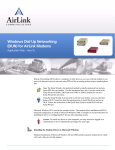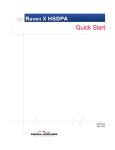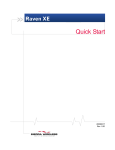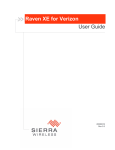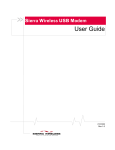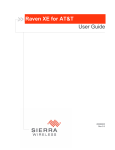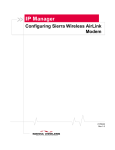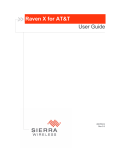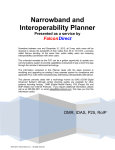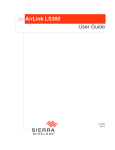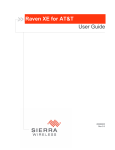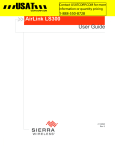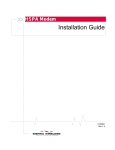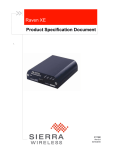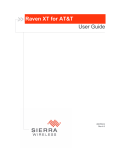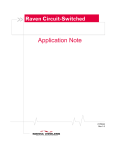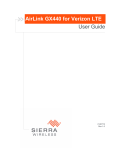Download Sierra Wireless 20070914 Modem User Manual
Transcript
Raven iDEN for TELUS Quick Start 20070914 Rev 3.0B Activating your Raven on the TELUS Network • • • • Installing the SIM Hardware Installation Indicator Lights Optional: Setting up a DUN Connection This Quick Start guide provides step‐by‐step directions for activating your Raven on the TELUS cellular network. Tip: For additional configuration options, refer to the User Guide for your Raven. Installing the SIM The SIM in the Raven is a smartcard securely storing the key identifying a cellular subscriber. Generally, you will only need to install a SIM once in the life of the modem and it may be pre‐installed by your Sierra Wireless Representative. 1. Before you start If the SIM was pre‐installed activation of your modem is complete. Skip to the Raven Placement section and/or to the DUN instructions, if you need Dial‐Up Networking. Cellular Account Required • Cellular account ‐ To use your modem you need to have a SIM (Subscriber Identity Module) with an active account with an iDEN cellular provider. Software Required • Terminal application ‐ for example Microsoft HyperTer‐ minal. Hardware Required Rev 3.0B Feb.08 • Serial cable ‐ A straight through serial cable. • Power adapter and a power source ‐ You will need a power supply and power source for the modem. • PC or Laptop ‐ To configure the modem, you will need a computer with an available serial port. 2 Raven iDEN Tools Required • Small Phillips screw driver ‐ The Phillips screw driver is the one which is also called a plus (+) or X screw driver. • Slim stylus ‐ A PDA stylus, an unbent paperclip, or other such item. 1. Opening the Case a. Unplug the Raven power and all cables. b. Using a small phillips head screw driver, remove the screws on the back of the Raven. c. Slide the case off of the Raven and set it aside. Figure 0-1: Partially removed case 2. a. Carefully remove the SIM card from the card you got from TELUS. 3. Ejecting the SIM tray Tip: The button is between two boards. Figure 0-2: SIM tray button 3 20070914 4. Insert the SIM into the Tray Note: The card and SIM may be a different color than these examples. a. Remove the SIM from the card you obtained from your TELUS. Figure 0-3: Sample of a Card with SIM Figure 0-4: Insert SIM in to the modem b. Place the SIM into the tray and gently press to click it into place. Figure 0-5: Empty SIM Tray and a Tray with a Sample SIM 5. Insert the Tray and SIM a. Slide the tray back into the modem. b. Gently press to click it into place. Tip: The top of the card faces the bottom of the modem. Rev 3.0B Feb.08 4 Raven iDEN Figure 0-6: Inserting the SIM 6. Finishing the SIM installation a. Slide the Raven back into the case. b. Secure the back of the Raven with the screws. Once you have the SIM installed, the final step for it to work with your Raven is issuing a master reset. You will need to connect to the Raven using a terminal application such as HyperTerminal with the Raven connected directly to your computer. You can access and configure your Raven using a terminal application such as Microsoft HyperTerminal, PuTTY, or similar. The following directions are for HyperTerminal which is part of a standard installation of Windows XP. Start > All Programs > Accessories > Communications > HyperTer‐ minal 5 20070914 Figure 0-7: HyperTerminal 1. Choose a name and icon for your connection. a. Choose a name for your connection, such as Raven or Sierra Wireless AirLink Solutions. The name and icon are only for your own reference so you can find the connection at a later date. Tip: If you want to have a connection saved for both local and remote, it is recommended the connection name reflect the connection type, i.e. Raven local. b. Select OK. 2. Connect To a. Select COM1, or the comport to which the modem is connected, for the “Connect Using”. Rev 3.0B Feb.08 6 Raven iDEN Figure 0-8: Connect To b. Type in 192.169.13.31 for Host Address. c. Change the “Port Number” to 2332. d. Select OK. 3. Port Settings (serial only) a. Change or verify the settings: · Bits per Second: 115200 (default) · Data Bits: 8 · Parity: None · Stop Bits: 1 · Flow Control: Hardware. 7 20070914 Figure 0-9: Port Settings Tip: If you have configured the Raven for settings different than the defaults for Bits per Second, Data Bits, Parity, and/or Stop Bits, you will need to use your changed settings. b. Select OK. 4. Connected Figure 0-10: HyperTerminal : connected a. Type AT and press Enter. You should get a reply of “OK” or “0”. Rev 3.0B Feb.08 8 Raven iDEN b. To see what you are typing as you type it, you will need to turn on the echo and verbose mode. Type ATE1V1 and press Enter. c. If you get a reply of “OK”, then you entered the command successfully. If you get a reply of “0” or “ERROR”, try entering the command again. 5. Enter the Master Reset Command for iDEN a. Type AT*PROVISION=000000, 0123456789 b. The Raven should respond with: “Master Reset Succeeded”. With any other response, contact TELUS to check the account status. c. Press the reset button on the Raven. The Raven should now register on the network. Hardware Installation Your Raven should be mounted in a position that allows easy access for the cables so they are not bent, constricted, in close proximity to high amperage, or exposed to extreme tempera‐ tures. The LEDs on the front panel should be visible for ease of operational verification. You should ensure that there is adequate airflow around the modem but that it is kept free from direct exposure to the elements, such as sun, rain, dust, etc. In a mobile location, such as a car or truck, ensure the location is secure both against abrupt movements of the vehicle and from other items coming into contact with the modem. Caution: The Raven is in a hardened case and designed for use in industrial and extreme environments. However, unless you are using cables expressly designed for such environments, they can fail if exposed to the same conditions the Raven can withstand. 9 20070914 Power Cellular Serial Figure 0-11: Raven Connectors Figure 0-12: Cellular Antennas selected should not exceed a maximum gain of 5 dBi under standard installation configuration. In more complex installations (such as those requiring long lengths of cable and/ or multiple connections), it’s imperative that the installer follow maximum dBi gain guidelines in accordance with the radio communications regulations of the Federal Communica‐ tions Commission (FCC), Industry Canada, or your country’s regulatory body (if used outside the US). • RSS‐102 (...Health Canada’s Safety Code 6 for Exposure of Humans to RF Fields) • RSS‐129 (800 MHz Dual‐Mode CDMA Cellular Telephones) (Analogue & CDMA) • RSS‐133 r1 (2 GHz Personal Communications) • http://www.industrycanada.ca. Your Raven will work with most Dual‐Band PCS cellular antennas with a TNC connector that works in the high and low frequencies of the cellular technology of your modem. Connect the primary antenna or primary RF cable directly to the antenna connector on the back of the Raven. Tip: When using a cable to an antenna placed away from the modem, minimize the length of your cable. All gain from a more advantageous antenna placement can be lost with a long cable to the modem. Rev 3.0B Feb.08 10 Raven iDEN Power Your Raven can be used with either DC, available in most automobiles, or 110 AC, standard US wall power, with the appropriate power adapter. DC cables and AC adapters are available as optional accessories in addition to the one included with your Raven. Note: When using a DC power source (such as a car battery or solar cell), Sierra Wireless recommends placing a fuse (1-2 Amp) on the line close to the power source to protect your power source from possible surges due to shorts or other line issues. The DC power cable positive lead should be connected to the battery or power source positive terminal. The power cable negative lead should be connected to the battery or power source negative terminal. Connecting to a Computer or other Device Figure 0-13: Serial The serial port of your Raven can be connected directly to most computers or other devices using a standard straight through cable. If you have a DCE device, you will need a null modem or null modem cable. Indicator Lights When your Raven is connected to power and an antenna, there is a specific pattern to the lights to indicate its operation mode. Figure 0-14: Raven Indicator lights • 11 Chan (channel) ‐ Indicates the modem has acquired a network channel. 20070914 • Link ‐ Indicates a successful connection to the cellular network. • Reg (registration) ‐ Indicates the Raven has acquired an IP fromTELUS. • RSSI (signal level) ‐ Light shows the strength of the signal and may be nearly solid (strong signal) or flashing (weaker signal). A slow flash indicates a very weak signal. RSSI LED Ranges RSSI/Signal LED Status Ranges of RSSI (dBm) On Solid Equal to or stronger than -69 Fast Blink -70 to -79 Normal blink -80 to -89 Slow Blink -90 to -99 Extinguished Equal to or weaker than -100 • TxRx (transmit/receive) ‐ The light will flash as data is transferred to and from the Raven‐E modem on the remote network. • Pwr (power) ‐ Indicates the power adapter is connected and there is power getting to the Raven. • The Reset button performs the same function as unplugging power from the modem and plugging it back in. Reset will not alter any saved configuration settings. Light Patterns The LEDs on the front of the modem will respond in different patterns to indicate modem states. • Normal ‐ Each LED, mentioned above, lit as applicable. • Start up ‐ The LEDs will cycle from left to right. • PassThru mode ‐ The Chan, Reg, and Link LEDs will blink in tandem. The Tx and Rx LEDs will blink when trans‐ mitting or receiving data. Optional: Setting up a DUN Connection Rev 3.0B Feb.08 12 Raven iDEN Dial‐up Networking (DUN) allows a computer or other device to use the serial port on your Raven to connect to the Internet or private network using PPP just like an analog modem using a standard phone line. Caution: To install any driver on your computer, you may need to be logged in as Administrator or have Administrator privileges for your login. Microsoft Windows XP is used in the examples below. The modem driver installation and DUN setup and configuration is similar in Microsoft Windows products. Examples are not provided here for installing the driver or configuring DUN for any other operating system. Installing a modem driver for Raven \ Standard installations of Microsoft Windows XP and 2000 include a generic modem driver which will work with your Raven. 1. Connect the Raven. a. Connect the modem to the computer with a DB‐9 cable or the USB port in serial mode. . b. Plug in the AC adapter, connect the antenna(s) and power on the modem. 2. Install the driver. a. Select Start > Control Panel > Phone and Modem Options (in Classic View). 13 20070914 Figure 0-15: Phone and Modem Options b. Select the Modems tab. Figure 0-16: Phone and Modem Options: Modems c. Rev 3.0B Feb.08 Select Add. 14 Raven iDEN Figure 0-17: Add Hardware Wizard d. Check Don’t detect my modem; I will select it from a list. e. Select Next. Figure 0-18: Add Hardware Wizard: Install New Modem f. Select (Standard Modem Types) from the Manufacturers column. g. Select Standard 33600 bps Modem from the Models column. 15 20070914 Tip: If you have the speed for your modem configured as something other than the default, use the Standard Modem that matches the speed you configured. h. Select Next. Figure 0-19: Add Hardware Wizard: Select Ports i. Check Selected Ports j. Select the COM port the modem is connected to (commonly COM1). k. Select Next. Figure 0-20: Add Hardware Wizard: Finish l. Rev 3.0B Feb.08 Once the modem driver is installed, select Finish. 16 Raven iDEN 3. Configure the driver. When you return to the Phone and Modem Options window, you should see the newly installed modem “attached to” the correct COM port. Figure 0-21: Phone and Modem Options: Modems a. Highlight the modem and select Properties. Figure 0-22: Modem Properties 17 20070914 b. Select the Modem tab. Figure 0-23: Modem Properties: Modem c. Maximum Port Speed should be set to 115200 (default). d. Select OK to exit. e. Select OK again to exit out of the Phone and Modem Options. Creating a Dial-Up Networking (PPP) Connection Once you have the driver for the modem installed on your computer, you can set up and configure Dial Up Networking (DUN) to use the modem as your connection to the Internet using PPP. Note: No other device or program can be using the same COM port (serial port) configured for the modem driver. Caution: If you have an existing LAN connection, installing DUN for the modem may interfere with the LAN connection. It's recommended to disconnect your LAN connection before using a PPP connection with your Raven. Rev 3.0B Feb.08 18 Raven iDEN Once the DUN connection is initiated, by default, it will take over as the “default route” for network communication and specifically for Internet access. If you want the two connections to co‐exist, you will need to de‐select “Use default gateway on remote network” (described later) and use the route command in Windows to setup routing through the modem properly. This guide does not provide information on the route command. You may need to consult with your network admin‐ istrator to properly configure routing. 1. Create a new network connection. a. Select Start > Connect To > Show All Connections to open the Network Connections window. Figure 0-24: Windows : Start menu b. Select Create a New Connection under Network Tasks in the menu area on the left. 19 20070914 Figure 0-25: Create New Connection c. Select Next to start installing and configuring the DUN connection. Figure 0-26: New Connection Wizard d. Select Connect to the Internet. e. Select Next. Rev 3.0B Feb.08 20 Raven iDEN Figure 0-27: New Connection: Type f. Select Set up my connection manually. g. Select Next. Figure 0-28: New Connection: How do you want to connect? h. Select Connect using a dial‐up modem. i. Select Next. Figure 0-29: New Connection: Connect using... j. Optional: If you have multiple modems installed on your computer, you may be prompted to select the modem to be used. If you only have one modem installed, this option will be omitted. k. Check Standard 33600 bps Modem. l. 21 Select Next. 20070914 Figure 0-30: New Connection: Select Modem m. Type in a name for the connection, such as Sierra Wireless AirLink Modem. n. Select Next. Figure 0-31: New Connection: Connection Name Tip: The name provided here will not effect the connection in any way. It is only a label for the icon. It can be the name of your wireless service provider (Provider), your modem (Raven), or any other designation for the connection. o. Type in 10001 as the phone number for the modem to dial. p. Select Next. Figure 0-32: New Connection: Phone Number q. Optional: If you have multiple users configured for your computer, you may be prompted for Connection Availability. If you select My use only, the account currently logged on will be the only one able to use this DUN connection. r. Rev 3.0B Feb.08 Select Next. 22 Raven iDEN Figure 0-33: New Connection: Permissions Generally the modem takes care of the Account Information, User name and Password, for the connection, so you can leave the fields blank (unless otherwise instructed by Support). s. If you want to allow others to use the same login for the modem, select Use this account name and password.... t. Select Next. Figure 0-34: New Connection: Connection Information Caution: If you have a LAN connection to the Internet and select Make this the default Internet Connection for the DUN configuration, you will not be able to use the LAN to connect to the Internet and may also affect the network connection on your computer to the rest of the LAN. Select this option ONLY if the Raven will be your sole network connection. u. If you want to add a shortcut for this DUN connection to your desktop, check Add a shortcut. v. 23 Select Finish to exit the Network Connection Wizard. 20070914 Figure 0-35: New Connection: Finish 2. Configure the DUN connection After you complete the New Connection Wizard, there are a few more things you will want to configure in the connection. a. Select Properties. Figure 0-36: DUN Connection b. Uncheck Use dialing rules. Rev 3.0B Feb.08 24 Raven iDEN c. Check Show icon...when connected. d. Select Configure, below the Connect using line. Figure 0-37: DUN Properties e. Select 115200 as the Maximum speed. f. Check Enable hardware flow control. g. Do not check any other option. h. Select OK. 25 20070914 Figure 0-38: Modem Configuration i. Back at the main properties screen, select the Networking tab. Figure 0-39: Networking j. Select Settings. k. Remove the checks from all three PPP settings. l. Rev 3.0B Feb.08 Select OK. 26 Raven iDEN Figure 0-40: PPP Settings m. Select (highlight) Internet Protocol (TCP/IP) and then select Properties. Tip: For most configurations, you will be obtaining the IP address and the DNS server address automatically. n. Select Advanced. Figure 0-41: TCP/IP Properties o. Uncheck Use IP header compression. p. Check Use default gateway on remote network. q. Select OK. 27 20070914 Figure 0-42: Advanced TCP/IP Tip: You may want to check the Options tab and change the settings for applications you might be using. The default options are generally applicable for most uses. Caution: Unless specifically directed to do so by Support or your network administrator, you do not need to make any changes to the options on the Security tab. r. Select OK until you return to the Connect window. Connecting to the Internet Using DUN There are two methods you can use to connect with Raven to the Internet using DUN, AceView and the Windows DUN connection directly. AceView AceView is a small utility which can maintain your DUN connection and monitor the connection of your Raven to Provider. If you have not already installed AceView you can obtain the most recent version from the Sierra Wireless Airlink website. Note: The direct DUN connection features of AceView are not available in Windows 98 or Windows NT. This guide assumes you have a default installation of AceView. 1. Start AceView. Start > All Programs > AirLink Communications > AceView Rev 3.0B Feb.08 28 Raven iDEN 2. Enable the Connection. Figure 0-43: AceView: Menu a. Right‐click on the AceView window to open the menu. b. Select Connection Settings. Figure 0-44: AceView: Connection Settings c. Select Auto Start in the DUN section. d. Select Maintain Persistent Connection. When checked, AceView will continually check the DUN connection to ensure it is not down. If so, AceView will attempt to connect again. Tip: When using the DUN connection, make sure the IP Address is set to the local IP address of the modem, 192.168.13.31 by default. e. Select OK. f. OK. Windows DUN You can directly use the Dial‐up link for the DUN connection. 29 20070914 1. Start the DUN session. Start > Connect To > Sierra Wireless Airlink Modem If you named the connection differently, use the name of the PPP connection you made earlier. Figure 0-45: DUN Connection Tip: Generally you will not need to enter a Username or Password. If you do need to enter either, you can enter these parameters beforehand using *NETUID and *NETPW. 2. Select Dial to connect to the modem and the cellular network. Note: The speed shown in the connection is the speed between the modem and your computer, it is not the speed of the modem’s connection to Provider or the Internet. When you’re connected, an icon should appear in the system tray showing the connection status. Figure 0-46: Connection indicator Rev 3.0B Feb.08 30 Raven iDEN Caution: For DUN connections on a Windows Mobility or other nonpersonal computer, the DNS settings may not be configured with the DUN connection. You may need to go into the network settings and add DNS servers manually. 31 20070914 Important Notice Due to the nature of wireless communications, transmission and reception of data can never be guaranteed. Data may be delayed, corrupted (i.e., have errors) or be totally lost. Although significant delays or losses of data are rare when wireless devices such as the Sierra Wireless AirLink Raven are used in a normal manner with a well‐constructed network, the Sierra Wireless AirLink Raven should not be used in situations where failure to transmit or receive data could result in damage of any kind to the user or any other party, including but not limited to personal injury, death, or loss of property. Sierra Wireless accepts no responsibility for damages of any kind resulting from delays or errors in data transmitted or received using the Sierra Wireless AirLink Raven, or for failure of the Sierra Wireless AirLink Raven to transmit or receive such data. Safety and Hazards Do not operate the Sierra Wireless AirLink Raven in areas where blasting is in progress, where explosive atmospheres may be present, near medical equipment, near life support equipment, or any equipment which may be susceptible to any form of radio interference. In such areas, the Sierra Wireless AirLink Raven MUST BE POWERED OFF. The Sierra Wireless AirLink Raven can transmit signals that could interfere with this equipment. Do not operate the Sierra Wireless AirLink Raven in any aircraft, whether the aircraft is on the ground or in flight. In aircraft, the Sierra Wireless AirLink Raven MUST BE POWERED OFF. When operating, the Sierra Wireless AirLink Raven can transmit signals that could interfere with various onboard systems. Note: Some airlines may permit the use of cellular phones while the aircraft is on the ground and the door is open. Sierra Wireless AirLink Raven may be used at this time. The driver or operator of any vehicle should not operate the Sierra Wireless AirLink Raven while in control of a vehicle. Doing so will detract from the driver or operatorʹs control and operation of that vehicle. In some states and provinces, operating such communications devices while in control of a vehicle is an offence. Limitation of Liability Rev 3.0B Feb.08 The information in this manual is subject to change without notice and does not represent a commitment on the part of Sierra Wireless. SIERRA WIRELESS AND ITS AFFILIATES SPECIFICALLY DISCLAIM LIABILITY FOR ANY AND ALL i DIRECT, INDIRECT, SPECIAL, GENERAL, INCIDENTAL, CONSEQUENTIAL, PUNITIVE OR EXEMPLARY DAMAGES INCLUDING, BUT NOT LIMITED TO, LOSS OF PROFITS OR REVENUE OR ANTICIPATED PROFITS OR REVENUE ARISING OUT OF THE USE OR INABILITY TO USE ANY SIERRA WIRELESS PRODUCT, EVEN IF SIERRA WIRELESS AND/OR ITS AFFILIATES HAS BEEN ADVISED OF THE POSSIBILITY OF SUCH DAMAGES OR THEY ARE FORESEEABLE OR FOR CLAIMS BY ANY THIRD PARTY. Notwithstanding the foregoing, in no event shall Sierra Wireless and/or its affiliates aggregate liability arising under or in connection with the Sierra Wireless product, regardless of the number of events, occurrences, or claims giving rise to liability, be in excess of the price paid by the purchaser for the Sierra Wireless product. Patents Portions of this product may be covered by some or all of the following US patents: 5,515,013 5,629,960 5,845,216 5,847,553 5,878,234 5,890,057 5,929,815 6,169,884 6,191,741 6,199,168 6,339,405 6,359,591 6,400,336 6,516,204 6,561,851 6,643,501 6,653,979 6,697,030 6,785,830 6,845,249 6,847,830 6,876,697 6,879,585 6,886,049 6,968,171 6,985,757 7,023,878 7,053,843 7,106,569 7,145,267 7,200,512 D442,170 D459,303 and other patents pending. Copyright © 2008 Sierra Wireless. All rights reserved. Trademarks AirCard® and “Heart of the Wireless Machine®” are registered trademarks of Sierra Wireless. Watcher® is a trademark of Sierra Wireless, registered in the European Community. AirLink™ and AceWare™ are trademarks of Sierra Wireless. Sierra Wireless, the Sierra Wireless logo, the red wave design, and the red‐tipped antenna are trademarks of Sierra Wireless. Windows® is a registered trademark of Microsoft Corporation. Other trademarks are the property of the respective owners. Contact Information For support assistance for SouthernLINC and Private iDEN Sierra Wireless AirLink modems, please contact Digitial Highway first. Rev 3.0B Feb.08 ii Support Desk: Phone: 1-877-524-0430 Hours: 8:00 AM to 5:00 PM Eastern Time, Monday to Friday, except US Holidays E-mail: [email protected] Sales Desk: E-mail: [email protected] Post: Digital Highway 175 Hill Brady Road Battle Creek, Mi USA 49037 Web: www.digital-hwy.com Support Desk: Phone: 1-877-231-1144 Hours: 5:00 AM to 5:00 PM Pacific Time, Monday to Friday, except US Holidays E-mail: [email protected] Sales Desk: Phone: 1-510-781-4200 1-604-232-1488 Hours: 8:00 AM to 5:00 PM Pacific Time E-mail: [email protected] Post: Sierra Wireless America 3159 Corporate Place Hayward, CA USA 94545 Sierra Wireless 13811 Wireless Way Richmond, BC Canada V6V 3A4 Fax: 1-510-781-4299 1-604-231-1109 Web: www.sierrawireless.com Consult our website for up‐to‐date product descriptions, documentation, application notes, firmware upgrades, trouble‐ shooting tips, and press releases: www.sierrawireless.com Rev 3.0B Feb.08 iii Revision History Revision number Release date Changes 1.x 2003-2005 AirLink Communications documentation - CDPD, CDMA, and GPRS. 2.x Q2: 2005-Q2: 2007 AirLink Communications documentation - CDMA, EV-DO, EDGE, and HSDPA. 3.0 in draft Converted documentation from AirLink Communications documentation format into Sierra Wireless documentation format. Phase II of the conversion completed. Raven modem line documentation is revised. Rev 3.0B Feb.08 iv




































